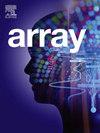Deep learning-based detection and classification of acute lymphoblastic leukemia with explainable AI techniques
IF 2.3
Q2 COMPUTER SCIENCE, THEORY & METHODS
引用次数: 0
Abstract
Leukemia is identified by an excess of immature white blood cells (WBC) being formed in the bone marrow, leading to cancer. It is divided into two main types: acute, which stems from early cell growth ab- normalities and involves rapid immature cell proliferation, and chronic, which progresses more slowly due to a blockage in the later stages of the cell life cycle. Detecting acute lymphoblastic leukemia (ALL) at an early stage is critical to reducing its associated mortality rate. This study presents an empirical analysis of various pre-trained deep learning models, including VGG16, VGG19, ResNet50, Xception, ResNet152, EfficientNet- B0, NASNetMobile, DenseNet169, DenseNet121, and EfficientNetV2B0, for the detection and classification of ALL. A comprehensive evaluation highlights the effectiveness of deep learning in distinguishing different types of ALL, demonstrating its potential as a reliable diagnostic tool in medical imaging. Additionally, we evaluated the performance of these models using different optimization techniques, including Adadelta, SGD, RMSprop, and Adam, to determine the most effective optimization strategy for improving classifica-tion accuracy. Our results demonstrate that EfficientNet-B0 achieved a classification accuracy of 72 %, while NASNetMobile attained 81 %. Notably, DenseNet121 outperformed these models with an accuracy of 99 %. Furthermore, the remaining seven models VGG16, VGG19, ResNet50, Xception, ResNet152, DenseNet169, and EfficientNetV2B achieved a perfect classification accuracy of 100 %, highlighting their robustness and effectiveness in our experimental setup. To improve the interpretability of the leukemia detection process, explainable AI techniques, including Grad-CAM, Score-CAM, and Grad-CAM++, were integrated to vi-sualize critical regions influencing model predictions. These techniques enhance transparency by providing visual explanations of classification decisions. A detailed comparative analysis was conducted, examining key parameters such as learning rate, optimization algorithms, and the number of training epochs to determine the most effective approach. The study leveraged a publicly available acute lymphoblastic leukemia dataset to ensure comprehensive model evaluation. By offering insights into model performance and interpretability.
基于深度学习的急性淋巴细胞白血病的检测和分类
白血病是由骨髓中形成的过量未成熟白细胞(WBC)确定的,导致癌症。它主要分为两种类型:急性,源于早期细胞生长异常,涉及未成熟细胞的快速增殖;慢性,由于细胞生命周期后期阶段的阻塞,进展较慢。早期发现急性淋巴细胞白血病(ALL)对降低其相关死亡率至关重要。本研究对各种预训练深度学习模型(包括VGG16、VGG19、ResNet50、Xception、ResNet152、EfficientNet- B0、NASNetMobile、DenseNet169、DenseNet121和EfficientNetV2B0)进行了实证分析,用于ALL的检测和分类。一项综合评估强调了深度学习在区分不同类型ALL方面的有效性,证明了其作为医学成像可靠诊断工具的潜力。此外,我们使用不同的优化技术(包括Adadelta、SGD、RMSprop和Adam)评估了这些模型的性能,以确定提高分类精度的最有效优化策略。我们的结果表明,EfficientNet-B0的分类准确率为72%,而NASNetMobile的分类准确率为81%。值得注意的是,DenseNet121以99%的准确率优于这些模型。另外,VGG16、VGG19、ResNet50、Xception、ResNet152、DenseNet169、EfficientNetV2B等7个模型的分类准确率均达到100%,显示了其在实验设置中的鲁棒性和有效性。为了提高白血病检测过程的可解释性,集成了可解释的AI技术,包括Grad-CAM、Score-CAM和Grad-CAM++,以可视化影响模型预测的关键区域。这些技术通过提供分类决策的可视化解释来提高透明度。进行了详细的比较分析,检查了学习率,优化算法和训练次数等关键参数,以确定最有效的方法。该研究利用了一个公开的急性淋巴细胞白血病数据集,以确保全面的模型评估。通过提供对模型性能和可解释性的洞察。
本文章由计算机程序翻译,如有差异,请以英文原文为准。
求助全文
约1分钟内获得全文
求助全文

 求助内容:
求助内容: 应助结果提醒方式:
应助结果提醒方式:


